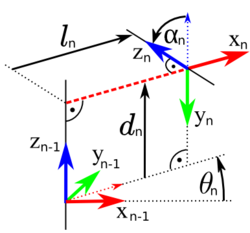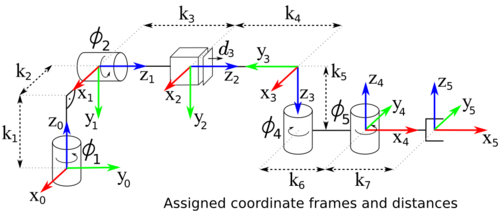Difference between revisions of "Denavit-Hartenberg parameters"
| Line 16: | Line 16: | ||
;<math>\alpha</math> | ;<math>\alpha</math> | ||
:The angle <math>\alpha</math> corresponds to the angle about the [[Common normal|common normal]] to align the <math>z_{n-1}</math>-axis with the new <math>z_{n}</math>-axis | :The angle <math>\alpha</math> corresponds to the angle about the [[Common normal|common normal]] to align the <math>z_{n-1}</math>-axis with the new <math>z_{n}</math>-axis | ||
| − | |||
;[[File:Hint.png|10px]] '''<span style="color:#ff0000">Special case</span>''' | ;[[File:Hint.png|10px]] '''<span style="color:#ff0000">Special case</span>''' | ||
Revision as of 15:11, 13 November 2015
| ← Back: Assigning coordinate frames | Overview: Denavit-Hartenberg Convention | Next: A-matrices → |
When the coordinate frames are assigned to a manipulator, the transformation between each two consecutive frames has to be described. Therefor the 4 Denavit-Hartenberg parameters  ,
,  ,
,  and
and  are used. The figure on the right shows two coordinate frames
are used. The figure on the right shows two coordinate frames  and
and  and the corresponding common normal represented by a dashed red line. The figure illustrates the Denavit-Hartenberg parameters, that are defined as follows:
and the corresponding common normal represented by a dashed red line. The figure illustrates the Denavit-Hartenberg parameters, that are defined as follows:

- The angle
 is defined as the angle about the
is defined as the angle about the  -axis to align
-axis to align  with the new
with the new  -axis.
-axis.

 is the offset or translation, respectively, along the
is the offset or translation, respectively, along the  -axis from the origin of
-axis from the origin of  to the intersection with the common normal.
to the intersection with the common normal.

- The parameter
 corresponds to the length of the common normal which is equivalent to the translation along it.
corresponds to the length of the common normal which is equivalent to the translation along it. - If the related joint
 is a revolute joint,
is a revolute joint,  can also be regarded as the radius of the rotation about the
can also be regarded as the radius of the rotation about the  -axis
-axis

- The angle
 corresponds to the angle about the common normal to align the
corresponds to the angle about the common normal to align the  -axis with the new
-axis with the new  -axis
-axis
The 4 parameters can rather be determined by just regarding the two coordinate frames, their axes and the common normal like visualized above. To completely understand the parameters and their meaning, the figure below illustrates what the parameters actually describe.  ,
,  ,
,  and
and  define 4 transformations that are applied consecutively to transform the coordinate frame
define 4 transformations that are applied consecutively to transform the coordinate frame  to
to  . First a rotation about the
. First a rotation about the  -axis by
-axis by  is applied followed by a translation along it by
is applied followed by a translation along it by  . Then the coordinate frame is rotated about the
. Then the coordinate frame is rotated about the  -axis by
-axis by  . Finally a translation along the
. Finally a translation along the  -axis leads to the next coordinate frame
-axis leads to the next coordinate frame  . Some further aspects about the meaning and the use of the 4 parameters are described in the following article about the A-matrices.
. Some further aspects about the meaning and the use of the 4 parameters are described in the following article about the A-matrices.
The video at the end of this page explains the assignment of the coordinate frames and the determination of the 4 parameters very vividly and comprehensibly.
|
Multimedial educational material
|
https://www.youtube.com/watch?v=qZB3_gKBwf8 Video: Assignment of coordinate frames and determination of the parameters (in German) |


















